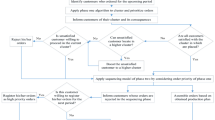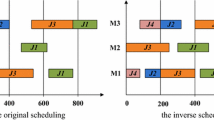Abstract
During the last years, the manufacturing industry is experiencing an increasing trend in the utilization of mixed-model assembly lines (MMALs). These lines, often adhering to the Just-In-Time production system, produce diversified products efficiently, maintaining least possible inventories. In this paper, the sequencing of an already balanced large scale double MMAL, manufacturing cars, is modeled as an integer mathematical programming problem and optimized over four objective functions. Two classical multiobjective methods are implemented to solve the mathematical integer programming problem, as well as a synergy of them. The former two are: the compensatory one, global criterion method, and the non-compensatory one, method of satisfactory goals, proposed by Benson. In addition, the model is solved using a combination of the aforementioned methods, as proposed by the authors, which is coupling certain characteristics from both. All three methods make use of the preferences, extracted from a real decision maker, responsible for the management of the production, who is enabled to choose the most preferred among the optimal solutions. Finally, the results, obtained from the implementation of the three separate methods, are assessed with regard to their effectiveness and efficiency.







Similar content being viewed by others
References
Bard JF, Shtub A, Joshi SB (1994) Sequencing mixed-model assembly lines to level parts usage and minimize line length. Int J Prod Res 32:2431–2454
Bouyssou D, Pirlot M (2005) A characterization of concordance relations. Eur J Oper Res 167(2):427–443
Boysen N, Fliender M, Scholl A (2009) Sequencing mixed-model assembly lines: survey, classification and model critique. Eur J Oper Res 192:349–373
Branke J, Deb K, Miettinen K, Slowinski R (eds) (2008) Multiobjective optimization: interactive and evolutionary approaches of LNCS, vol 5467. Springer, Berlin
Chankong V, Haimes YY (1983) Multiobjective decision making: theory and methodology. Elsevier Science, New York, and Dover Publications, Incorporated, 2008
Ehrgott M, Gandibleux X (2002) Multiple criteria optimization: state of the art annotated bibliographic surveys, vol 52. Kluwer’s international series in operations research and management science, Boston
Ehrgott M, Gandibleux XA (2000) Survey and annotated bibliography of multiobjective combinatorial optimization. OR Spektrum 22:425–460
GAMS Development Corporation (2010) General algebraic modeling system (GAMS), release 23.5.2. Washington, DC. http://www.gams.com. Accessed 31 Aug 2015
Hwang CL, Masud ASM (1979) Multiple objective decision making: methods and applications. Springer, Berlin
Hyun CJ, Kim Y, Kim YK (1998) A genetic algorithm for multiple objective sequencing problems in mixed model assembly lines. Comput Oper Res 25:675–690
Keeney RL (1980) Siting energy facilities. Academic Press, New York
Keeney RL, Raiffa H (1976) Decisions with multiple objectives: preferences and value tradeoffs. Wiley, New York
Korkmazel T, Meral S (2001) Bicriteria sequencing methods for the mixed-model assembly line in just-in-time production systems. Eur J Oper Res 131:188–207
Makarouni I, Psarras J, Siskos E (2015) Interactive bicriterion decision support for a large scale industrial scheduling system. Ann Oper Res 227(1):45–61
Mavrotas G (2009) Effective implementation of the \(\epsilon \)-constraint method in multi-objective mathematical programming problems. Appl Math Comput 213:455–465
McMullen PR (2001) An efficient frontier approach to addressing JIT sequencing problems with setups via search heuristics. Comput Ind Eng 41:335–353
Monden Y (1983) Toyota production system: a practical approach to production management. Industrial Engineering and Management Press, Georgia
Rahimi-Vahed AR, Rabbani M, Tavakkoli-Moghaddam R, Torabi SA, Jolai F (2007) A multi-objective scatter search for a mixed-model assembly line sequencing problem. Adv Eng Inf 21:85–99
Roy B, Bouyssou D (1993) Aide Multicritère à la Décision : méthodes et Cas, Economica, Paris
T’kindt V, Billaut JC (2005) Multicriteria scheduling: theory, models and algorithms, 2nd edn. Springer, Berlin
Author information
Authors and Affiliations
Corresponding author
Rights and permissions
About this article
Cite this article
Makarouni, I., Siskos, E. & Psarras, J. Multiobjective large scale job sequencing optimization based on a synergy of compensatory and non compensatory methods. Oper Res Int J 16, 223–244 (2016). https://doi.org/10.1007/s12351-015-0195-8
Received:
Revised:
Accepted:
Published:
Issue Date:
DOI: https://doi.org/10.1007/s12351-015-0195-8




